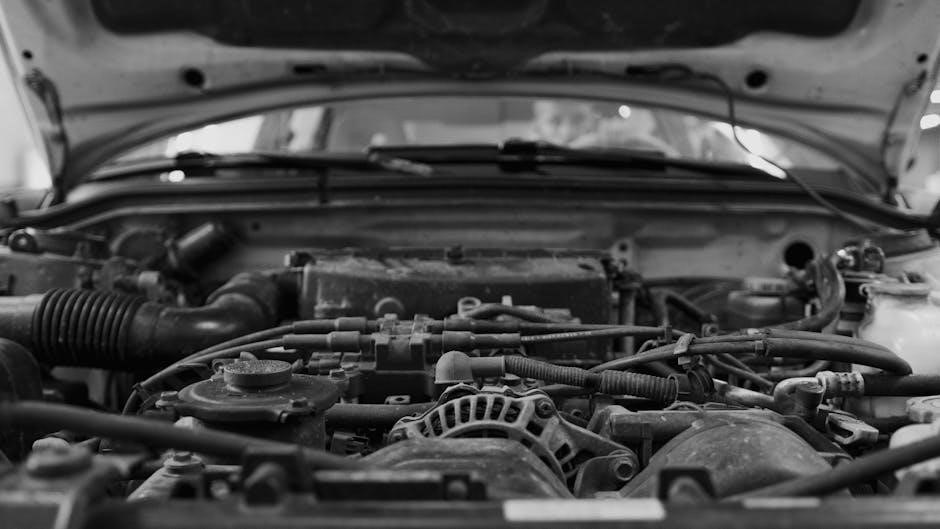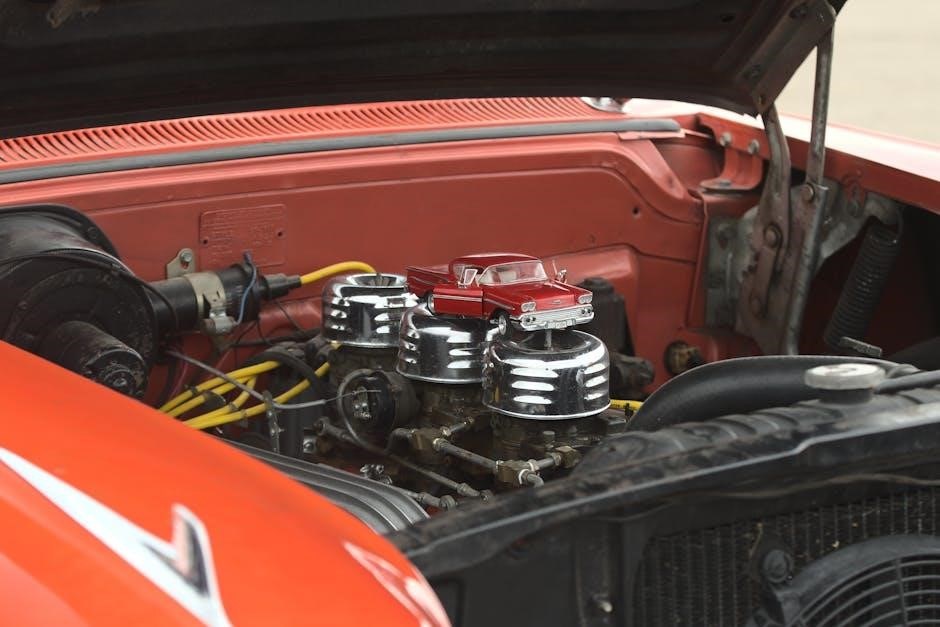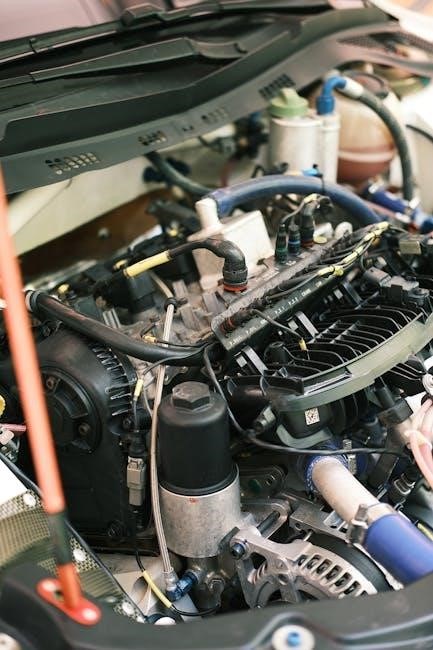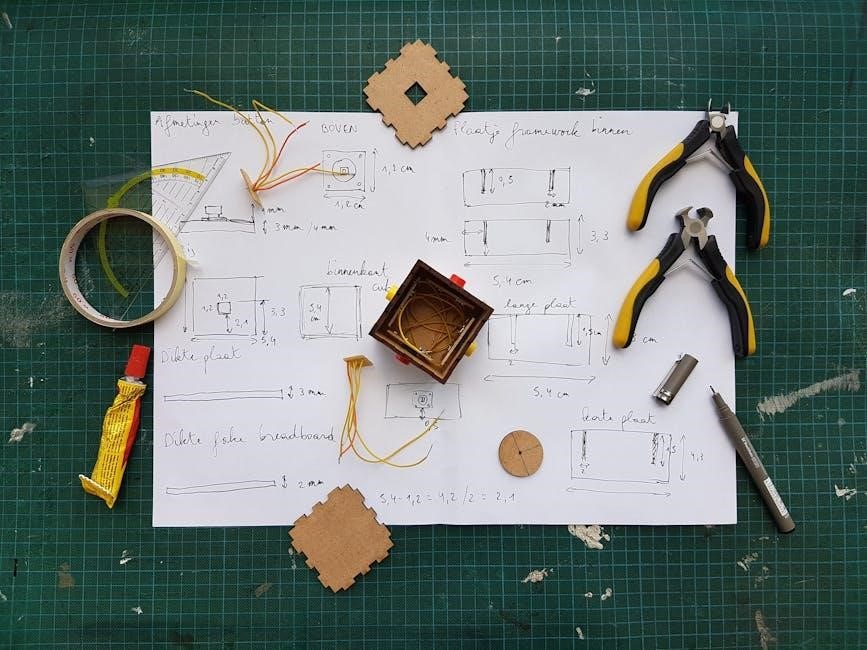Three-phase motor starters are crucial devices that safely initiate, operate, and halt three-phase induction motors. They provide overload protection and enable controlled starting, often using wiring diagrams for proper installation and troubleshooting.
Understanding Three-Phase Motor Starters
Definition and Function of a Motor Starter
A motor starter is a device or a combination of devices used to start, stop, protect, and control three-phase motors. Its primary function is to provide a safe and efficient method for energizing the motor while limiting the inrush current during startup. Furthermore, motor starters include overload protection to prevent damage to the motor due to excessive current draw caused by faults or overloads. Wiring diagrams are essential for understanding and implementing the correct connections.
Three-phase motor starters consist of several components that work in harmony. Key components include a disconnect switch, a control transformer, overload protection devices, and the motor starter itself, all guided by wiring diagrams.
Disconnect Switch
The disconnect switch is a critical safety component within a three-phase motor starter. It’s designed to isolate the motor from the power supply, enabling safe maintenance and repairs. Wiring diagrams often highlight the disconnect switch’s placement in the power circuit. This switch ensures that all phases are de-energized simultaneously, protecting personnel from electrical hazards during servicing. Proper selection and implementation of the disconnect switch are essential for a secure motor control system.
Control Transformer
A control transformer reduces the high voltage of the power circuit to a lower, safer voltage for the control circuit. This ensures the safe operation of pushbuttons, relays, and other control components. Wiring diagrams clearly show how the transformer steps down the voltage. Typically 480V to 120V or 240V to 120V. This enhances safety for operators and maintenance personnel. It also isolates the control circuit from the main power supply, preventing damage.
Components of a Three-Phase Motor Starter
Overload Protection Devices
Overload protection devices safeguard the motor from excessive current draw, preventing overheating and potential damage. These devices, such as thermal overload relays, monitor the motor’s current and trip the starter if the current exceeds a preset level. Wiring diagrams illustrate how these devices are connected in the motor circuit. These devices are crucial for extending motor life and ensuring operational safety. They are typically adjustable to match the motor’s full-load ampacity. They are a critical component in a motor starter assembly.
Direct-On-Line (DOL) Starters
Three-phase motor starters come in several types, including Direct-On-Line (DOL) and Star-Delta starters, each with unique wiring diagrams. DOL starters provide full voltage to the motor, while Star-Delta starters reduce voltage during startup.
Direct-On-Line (DOL) Starters
Direct-On-Line (DOL) starters represent a fundamental approach to initiating three-phase motors, characterized by their straightforward wiring diagrams and operational simplicity. A DOL starter directly connects the motor to the full line voltage, providing 100% of the available voltage immediately. This method is suitable for applications where the high inrush current during startup is acceptable. Wiring diagrams for DOL starters typically involve a contactor, overload relay, and start/stop buttons, facilitating easy understanding and implementation. While simple, DOL starters may cause voltage dips in the power supply due to the high starting current.
Types of Three-Phase Motor Starters
Star-Delta Starters
Star-delta starters are a reduced voltage starting method for three-phase induction motors, commonly used to decrease the inrush current during startup. Initially, the motor windings are connected in a star configuration, reducing the voltage applied to each winding to approximately 58% of the line voltage. After a pre-set time, a timer switches the connection to a delta configuration, applying full voltage to the windings. Wiring diagrams for star-delta starters are more complex than DOL starters, involving multiple contactors, a timer, and a more intricate control circuit. This complexity allows for smoother acceleration and reduced stress on the electrical grid.
Wiring diagrams are essential for understanding the electrical connections within a three-phase motor starter. They provide a visual representation of the circuit, aiding in installation, troubleshooting, and maintenance, ensuring safe and efficient operation.
Importance of Wiring Diagrams
Wiring diagrams play a pivotal role in the successful implementation and maintenance of three-phase motor starters. They serve as a comprehensive roadmap, illustrating the interconnection of components such as disconnect switches, control transformers, and overload protection devices. A clear wiring diagram ensures accurate connections during installation, minimizing the risk of errors that could lead to equipment damage or hazardous conditions. Furthermore, these diagrams are invaluable for troubleshooting, enabling technicians to quickly identify and resolve wiring faults, thereby reducing downtime and ensuring optimal motor performance, and promoting safety.
Wiring Diagrams: An Overview
Reading Line Diagrams (Schematics)
Line diagrams, also known as schematics, are essential for understanding the control logic of a three-phase motor starter. Unlike pictorial diagrams, schematics use symbols to represent components and lines to indicate connections. Comprehending these diagrams involves recognizing common symbols for relays, contacts, coils, and other devices. It’s important to trace the flow of current through the circuit to understand how the starter functions. By analyzing the schematic, one can determine the sequence of operations, identify potential faults, and effectively troubleshoot control circuit issues, ensuring efficient and safe operation of the motor starter system.
A typical wiring diagram shows both power and control circuits. The power circuit includes connections for the three-phase power supply and motor, while the control circuit manages the starter’s operation with start/stop buttons.
Power Circuit Wiring
Power circuit wiring in a three-phase motor starter diagram illustrates how the main power supply connects to the motor. This circuit typically includes three phases (R, Y, B) linked to the motor through a disconnect switch and overload protection. Heavy dashed lines indicate field power wires, ensuring proper current flow. Fuses or circuit breakers protect against short circuits, crucial for system safety and reliable motor operation according to the starter’s wiring diagram documentation, ensuring correct connections.

Typical Wiring Diagram for a Three-Phase Motor Starter
Control Circuit Wiring
Control circuit wiring manages the motor starter’s operation using lower voltage, often 115V AC or 24V DC. This circuit includes start/stop buttons, relays, and contactor coils connected to the starter and overload devices. The control circuit enables remote operation, interlocking, and safety functions. Line diagrams, or schematics, show the operational logic, not the physical layout. Ensure proper connections between the phase and neutral, referring to wiring diagrams for accuracy. Correct control wiring is essential for reliable motor control.
Safety is paramount when working with three-phase motor starters. Employ fuses and circuit breakers to protect against short circuits. Ensure the starter, motor, and cabling are adequately protected, and always consult wiring diagrams for safety information.
Fuses and Circuit Breakers
Fuses and circuit breakers are essential safety components in a three-phase motor starter system. They protect the motor and wiring from overcurrent conditions that can arise due to short circuits or excessive loads. Properly rated fuses or circuit breakers will interrupt the current flow, preventing damage to the motor, starter components, and the overall electrical system. Consulting the wiring diagram is critical for selecting the correct fuse or breaker size to ensure adequate protection without nuisance tripping. Regular inspection and maintenance of these devices are vital for maintaining a safe operating environment.

Safety Considerations
Overload Unit Settings
Proper overload unit settings are critical for safeguarding three-phase motors. The overload unit, often a thermal or electronic device, protects the motor from damage due to sustained overcurrent conditions, such as those caused by mechanical overload or voltage fluctuations. Setting the overload unit to match the motor’s full-load amperage (FLA), as specified on the motor’s nameplate, ensures appropriate protection. Consult the wiring diagram and motor specifications to determine the correct settings. Regular verification of these settings and periodic testing of the overload unit are vital for maintaining motor longevity and preventing costly downtime.
Three-phase motor starters are essential in industrial machinery for controlling motors in equipment like pumps, compressors, and conveyors. Their wiring diagrams ensure correct and safe operation, enhancing efficiency and preventing motor damage.
Industrial Machinery
In industrial settings, three-phase motor starters are indispensable for operating heavy machinery. These starters, often guided by wiring diagrams, control motors within equipment such as pumps, compressors, and various automated systems. Correct wiring, as per the diagrams, ensures efficient and safe operation, preventing motor burnout and downtime. Clear PDF resources of these diagrams are essential for technicians to properly install, maintain, and troubleshoot these systems, contributing to overall productivity and safety in industrial environments.

Applications of Three-Phase Motor Starters
HVAC Systems
Three-phase motor starters are fundamental components in Heating, Ventilation, and Air Conditioning (HVAC) systems. They manage the operation of large motors found in air handlers, chillers, and industrial-scale ventilation fans. A precise wiring diagram, often available as a PDF, is vital for correct installation and maintenance. These diagrams ensure that the motors start and stop safely, and are protected from overloads, contributing to the efficient and reliable operation of the entire HVAC system, and guaranteeing climate control and energy efficiency in buildings.
Troubleshooting motor starter issues often involves identifying wiring errors using a wiring diagram PDF. Common problems include incorrect connections, loose terminals, or damaged wires, leading to motor malfunction or failure to start.
Identifying Wiring Errors
When troubleshooting a three-phase motor starter, start by carefully comparing the existing wiring with the wiring diagram PDF. Look for discrepancies such as misconnected wires, wires connected to the wrong terminals, or any loose connections. Pay close attention to the control circuit wiring, as errors there can prevent the motor from starting or stopping correctly. Check for any signs of physical damage to the wires, such as cuts or frayed insulation. Correct wiring errors to ensure safe and proper motor operation.
Troubleshooting Common Wiring Issues
Using a Multimeter for Testing
A multimeter is essential for troubleshooting three-phase motor starter wiring. Use it to check for proper voltage levels at various points in the circuit, comparing readings to the wiring diagram PDF specifications. Test for continuity to ensure wires are correctly connected and not broken. Check for shorts between wires or to ground. Measure the resistance of the motor windings to identify potential issues. A multimeter helps to diagnose problems like blown fuses, faulty contacts, and incorrect voltage, ensuring safe and efficient troubleshooting.
Accessing PDF downloads of three-phase motor starter wiring diagrams is invaluable. These resources provide visual aids for understanding circuit layouts, aiding in installation, troubleshooting, and maintenance. They offer detailed schematics for various starter types.
PDF Downloads of Wiring Diagrams
PDF downloads offer readily available wiring diagrams for various three-phase motor starters. These downloadable resources often include detailed schematics for Direct-On-Line (DOL) and Star-Delta starters, which are crucial for electrical technicians and engineers. They provide a visual representation of the power and control circuits, aiding in installation and troubleshooting. These diagrams are an essential tool for understanding the proper connections and ensuring safe operation. Accessing these PDFs can significantly enhance comprehension and reduce wiring errors during motor starter implementation and maintenance procedures.

Resources and Further Learning
Manufacturer Websites and Technical Support
Manufacturer websites are invaluable resources for obtaining specific three-phase motor starter wiring diagrams and technical support. These sites provide detailed product documentation, application notes, and safety guidelines. Many manufacturers offer downloadable PDF files, CAD drawings, and interactive tools to assist with wiring and troubleshooting. Furthermore, access to their technical support teams can provide expert advice and assistance with complex wiring scenarios or unique application requirements. Consulting manufacturer resources ensures accurate and reliable information, promoting safe and efficient motor starter installations and maintenance practices for optimal performance;